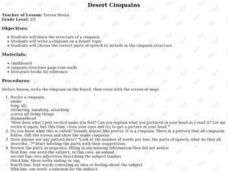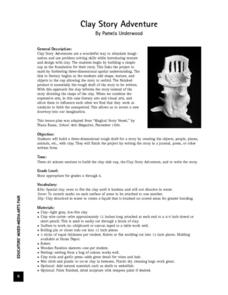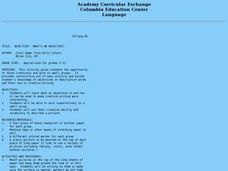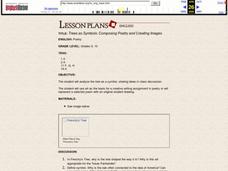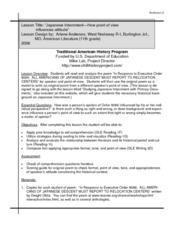Curated OER
The Voices Within Theirs and Mine
Students create new words to convey their thoughts. They find, list and discuss the poetic devices used by the poet in creating his or her war poem and create their own war poems. They use sensory perception words and memory in...
Facing History and Ourselves
What Shapes Your Identity?
Sixth graders explore their individual identities. In this personal identity lesson, 6th graders write biopoems using the provided template. Students share their poems and respond to the poetry shared.
Curated OER
Desert Cinquains
Students use the cinquain structure and correct parts of speech to write a poem with a desert theme.
Curated OER
Transforming Negatives to Positives
Students write diamonte poems that correspond to the double-exposed photograph they created. In this poetry and multimedia artwork instructional activity, students use the photographic process to create a double-exposed...
Curated OER
Finding Synonyms
Student identify synonyms in poetry. For this grammar lesson, young scholars define what a synonym is and view several examples on the board. Students read a selected poem on an overhead transparency and circle the synonyms.
Curated OER
Clay Story Adventure
Students build three-dimensional rough draft for a story by creating objects, people, places, animals, etc., with clay, and write story in a journal, poem, or other written form.
Curated OER
Poets of Christmas Past
Students consider the meanings of Christmas by reading an op-ed. As a class, they then create a sequel to the poem "A Visit from Saint Nicholas," in which "Mamma" tells a story about the history of Christmas.
Curated OER
Memoir - The Gift of Memories
Learners create a memoir or poem about their favorite person or pet. In this favorite person or pet lesson plan, students also scan in pictures to PowerPoint and create a presentation about this person or pet as well.
Curated OER
Adjective? What's an Adjective?
Mount a variety of pictures (fantasy, rustic, portraits, action) on large sheets of paper and post them around the classroom. Groups rotate from poster to poster, adding adjectives to describe each of the pictures. Writers use these word...
Curated OER
Trees as Symbols: Composing Poetry and Creating Images
Young scholars analyze the tree as a symbol, sharing ideas in class discussion. They use art as the basis for a creative writing assignment in poetry or represent a selected poem with an original student drawing.
Curated OER
Resistance Poetry
Young scholars create a definition for the term resistance. Once a definition has been created, they create a visual image to correlate with their definition. Working in groups, students read several different resistance poems and...
Curated OER
Sybil Ludington's Ride - a poem
Fourth graders examine the role a teen from the Hudson Valley played in the American Revolution. They view the map of Sybil's ride and calculate the distance using the map's legend.
Curated OER
Veterans' Voyages
Introduce your middle and high schoolers to a different perspective on war: that of soldier's. Read Guisseppi Ungaretti's poem "Vigil" to kick-start this lesson. After discussing his perspective, read "The Screaming Eagles Fly to...
Curated OER
Japanese Internment--How Point of View Influences Attitude
How does background and experience influence one's point of view? Dwight Okita's famous poem about the Japanese internment is the text used to explore this essential question. Class members study primary documents to gain the necessary...
Teachers.net
Figurative Language
When is a staple remover a fanged monster? In your ELA classroom when you're teaching this fun figurative language lesson, of course! Get your young writers using figurative language by making a game of it. Give groups a paper bag full...
Curated OER
The First World War
Students examine the process and effects of World War I on different segments of the population, beyond the political, diplomatic and military framework of the war. They analyze the memoirs of soldiers, read poetry of the time, and...
Curated OER
Animal Fact or Fiction?
Read and discuss the article "Welcome to Cicadaville (Enter at Your Own Risk)" to gain a better understanding around the confusion regarding cicadas and locust swarms. In groups your young analysts research statements about animals to...
Curated OER
Music in Words
Your class can build strong, well-represented opinions about the music they hear. They listen to, and share thoughts about, a piece of classical music. Then they write a piece of music or a poem, and analyze their peers' work and their...
Curated OER
Black History Lesson Plan: Gwendolyn Brooks
Learn more about the work of Gwendolyn Brooks with a language arts lesson. Young learners read an informational passage about the acclaimed poet before attempting a shape poem of their own.
Curated OER
Comparing The Odyssey and "The Lotus Eaters"
Ninth graders compare the development of text in Book 5 of "The Odyssey" to Alfred Lord Tennyson's poem "The Lotus Eaters." After discussing the comparison's of the two text within a group, they create an original piece of work or...
Curated OER
Asking Questions
Students examine a painting that depicts a scene from the Underground Railroad. They discuss the painting and write journal entries and poems in response to the painting's themes and their impressions.
Curated OER
Do You Haiku? We Do!
Third graders try their hands at writing Haiku, a form of Japanese poetry. Haiku is usually 17 syllables in three-line form. This engaging lesson has many excellent worksheets and website imbedded in the plan. They share their finished...
Curated OER
Play with Words: Rhymes & Verse
Students listen to poems and rhymes, clap out syllables, and sing along with familiar tunes. They use puppets and crafts to help recall and retell favorite poems, and craft their own poems.
Curated OER
The Tell-Tale Hearts of Writers
Knock, knock, knock...Creep out your class with a critical thinking lesson focused on word relationships in Edgar Allen Poe's "The Tell-Tale Heart." They investigate the relationship between word choice, mood, and interpretation of...


